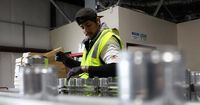The U.S. economy demonstrated surprising resilience in March 2025, adding 228,000 jobs, significantly exceeding economists' expectations of 140,000. This job growth, reported by the Labor Department, marks a rebound from a revised 117,000 jobs added in February. However, the unemployment rate also ticked up to 4.2%, slightly higher than the 4.1% recorded the previous month.
Despite the positive job numbers, the backdrop of President Donald Trump's recent tariff announcements looms large, creating uncertainty in the labor market. The tariffs, which include a flat 10% duty on all imports and additional levies on various goods, have sparked fears of a global trade war that could hinder economic growth. As a result, stock markets reacted negatively, with futures tied to the Dow Jones Industrial Average dropping significantly.
According to Lindsay Rosner, head of multi-sector fixed income investing at Goldman Sachs Asset Management, "Today's better than expected jobs report will help ease fears of an immediate softening in the U.S. labor market. However, this number has become a side dish with the market just focusing on the entrée: tariffs." This sentiment reflects the prevailing anxiety among investors regarding the potential long-term impacts of Trump's trade policies.
The March jobs report reveals that the health care sector led job growth, adding 54,000 positions, consistent with its performance over the past year. Other sectors also contributed positively, with social assistance and retail each adding 24,000 jobs, while transportation and warehousing saw a gain of 23,000 jobs. However, the federal government's workforce saw a decline of 4,000 positions, a trend attributed to the efforts led by Elon Musk’s Department of Government Efficiency, which has been tasked with streamlining government operations.
In a post on Truth Social, Trump celebrated the job numbers, stating, "GREAT JOB NUMBERS, FAR BETTER THAN EXPECTED. IT'S ALREADY WORKING. HANG TOUGH, WE CAN'T LOSE!!!" Yet, the job growth comes amid significant downward revisions for January and February, where a total of 48,000 jobs were cut from previous estimates.
While the job growth figures indicate a robust labor market, analysts caution that the uncertainty surrounding Trump's tariffs may lead to a slowdown in hiring in the coming months. Glen Smith, chief investment officer at GDS Wealth Management, noted, "While Friday's jobs report showed that the economy is still adding jobs even with the tariff uncertainty and federal job cuts, the data is backward-looking and doesn't say anything about how employers might fare over the coming months."
Moreover, a broader unemployment indicator, which accounts for those not actively seeking work as well as part-time workers, edged lower to 7.9%. The household survey, which helps determine the unemployment rate, showed a gain of 201,000 workers, with full-time employment increasing by 459,000, while part-time positions fell by 44,000.
The implications of Trump's tariffs are already being felt in various sectors. Stellantis, the parent company of Jeep, announced it would temporarily lay off about 900 workers across five manufacturing plants in Michigan and Indiana due to the new trade policies. Antonio Filosa, the company's Americas chief operating officer, stated that they are "continuing to assess the medium- and long-term effects of these tariffs on our operations, but also have decided to take some immediate actions."
China has also responded to the tariffs, announcing a slew of countermeasures that could further complicate the trade landscape. Analysts warn that the tariffs could lead to increased prices and disrupted supply chains, ultimately resulting in job losses as companies reassess their hiring strategies.
In addition to the immediate effects of the tariffs, the job market is facing challenges from a broader economic slowdown. Consumer confidence has dropped to a 12-year low, and there are growing concerns that the economy could stall in the coming months. The Federal Reserve is expected to cut interest rates again in response to the economic uncertainty, with officials projecting two cuts this year.
As the labor market continues to evolve, experts are closely monitoring the impact of Trump's policies on job growth. While March's numbers provide a glimpse of resilience, the coming months may reveal a different story as the ramifications of the tariffs take hold.
The March jobs report highlights the complexities of the current economic landscape, where job growth is juxtaposed with rising unemployment and increasing uncertainty. Economists remain cautious, as they predict that the effects of the new tariffs may soon overshadow the positive job numbers. The next employment report will be critical in assessing the ongoing impact of these economic policies.









